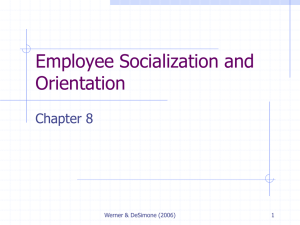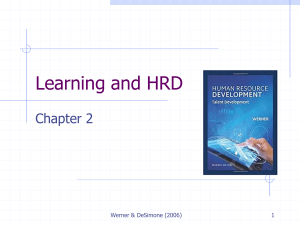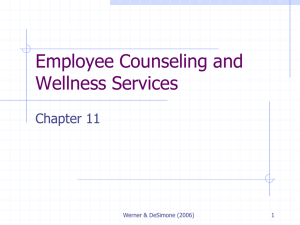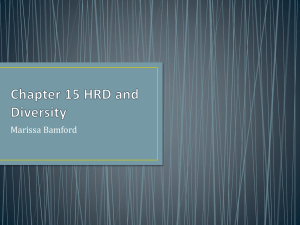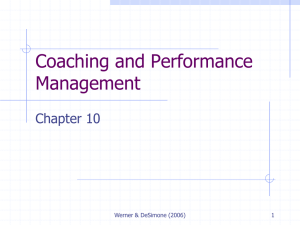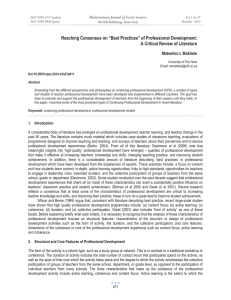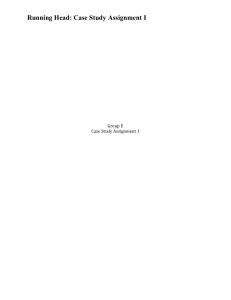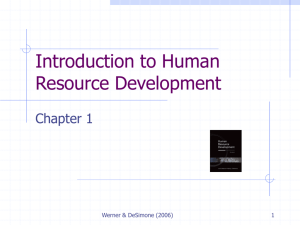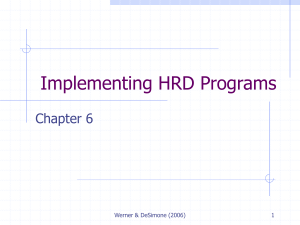Chapter12 - ernitaniusbiz
advertisement
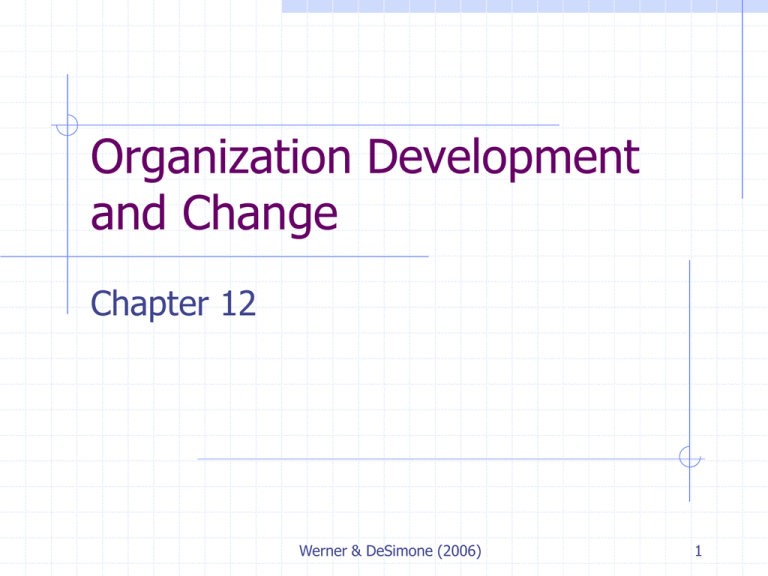
Organization Development and Change Chapter 12 Werner & DeSimone (2006) 1 Learning Objectives After learning this chapter, you should be able to: Define the organization development (OD). Understand the basic theories and concepts of OD. Describe the planned-change model. Explain the roles of the change agent, manager, and people within the system in developing an intervention strategy. Understand the basic steps involved in designing an implementation strategy. Describe several types of intervention strategies. Explain the different types of organization transformation intervention strategies. Werner & DeSimone (2006) 2 Organization Development (OD) Definition: “A process used to enhance both the effectiveness of an organization and the well-being of its members through planned interventions.” Werner & DeSimone (2006) 3 Organization Development Theories Two main categories of OD theories: Change process theory – How does change take place? Implementation theory – How can change strategies be put into practice? Werner & DeSimone (2006) 4 Organization Development Theories Change process theory – seeks to explain how organizations improve and change. According to Lewin and Schein, there are three stages: Unfreezing Change through cognitive restructuring Refreezing Werner & DeSimone (2006) 5 Organization Development Theories Implementation theory – how specific intervention strategies are designed and carried out. Four main types: Human process-based theory Technostructural theory Sociotechnical systems theory Organization transformation theory Werner & DeSimone (2006) 6 Caution About Organization Development Research Concerns have been expressed about much of the OD research that has been conducted: Lack of experimental designs Lack of resources available Limitations in field research designs used Potential bias by researchers Lack of motivation to conduct strong research Werner & DeSimone (2006) 7 Model of Planned Change By Permission: Porres & Silvers (1991) Werner & DeSimone (2006) 8 Model of Planned Change – 2 Porras & Silvers Model: 1. Change intervention (two categories): Organization transformation Organization development 2. Organizational target variables: Vision (beliefs, purpose, mission) Work setting (organizing arrangements, social factors, technology, physical setting) Werner & DeSimone (2006) 9 Model of Planned Change – 3 Porras & Silvers Model: 3. Individual organizational member: Cognitive change Behavior change Werner & DeSimone (2006) 10 Model of Planned Change – 4 Porras & Silvers Model: 4. Organizational outcomes: Improved organizational performance Enhanced individual development Question: What is the value of this model? Werner & DeSimone (2006) 11 Designing an Intervention Strategy Specific Roles: Change Manager Oversees the design of the strategy; bears ultimate responsibility Change Agent Assists the change manager; facilitates the activities involved Internal Change Agent (often an HRD professional) External Change Agent (consultant) Individuals Labor Unions Werner & DeSimone (2006) 12 Designing an Intervention Strategy – 2 Systems Approach: Diagnose the Environment e.g., force field analysis Develop an Action Plan objectives, activities, “details” Evaluate the Results of the Intervention Werner & DeSimone (2006) 13 Types of Interventions: Human Process-Based Survey Feedback The systematic collection of survey data Fed back to groups to promote problem solving and change Team Building A process to improve a group’s problemsolving abilities Example: process consultation Werner & DeSimone (2006) 14 Types of Interventions: Technostructural Job Enlargement Adding variety through similar tasks Job Enrichment Increasing responsibility, knowledge of results, and meaningfulness of work Alternative Work Schedules Compressed workweek Flextime work schedule Werner & DeSimone (2006) 15 Types of Interventions: Sociotechnical Systems Quality Circles Involving employees in work decisions Total Quality Management (TQM) Continuous improvement efforts Self-Managing Teams (SMTs) Team members have authority to make decisions and regulate the team’s activities Werner & DeSimone (2006) 16 Types of Interventions: Organizational Transformation Cultural Interventions Efforts to change the values, norms, or ways of thinking in an organization Strategic Changes Fundamental changes in the purpose or mission of an organization Becoming a Learning Organization Beyond TQM, to continuous learning and improvement for all employees High Performance Work Systems Werner & DeSimone (2006) 17 Some Concluding Thoughts on Organization Development 1. Effectiveness: There is evidence for the effectiveness of particular OD interventions. However, there is much room for improvement (in the research designs used, and the results obtained). 2. Recent efforts have stressed “change management.” Werner & DeSimone (2006) 18 Some Concluding Thoughts on Organization Development – 2 3. Many HRD applications can be viewed as OD interventions: Human Process-Based: career development, coaching, orientation Technostructural: skills/technical training Sociotechnical: team and quality training Organization transformation: EAPs, management development Werner & DeSimone (2006) 19 Summary Organization development can be difficult! Reluctance/resistance to change Success is most likely with: An appropriate model of change The appropriate methods/interventions A systems approach (e.g., high performance work systems, HRD process model) Need a dual focus on organizational performance and employee well-being Werner & DeSimone (2006) 20


